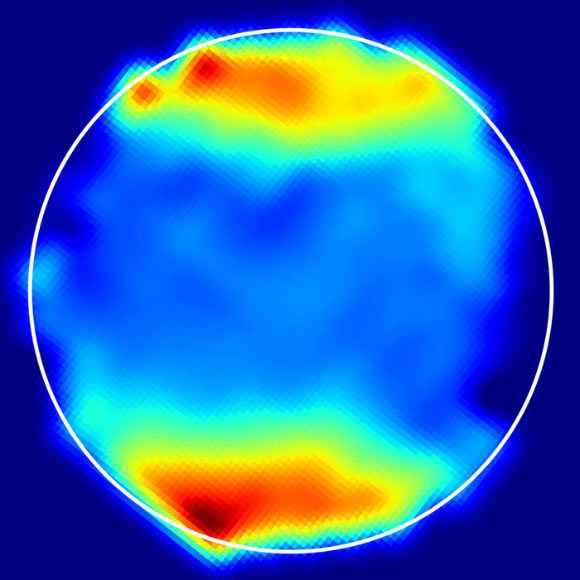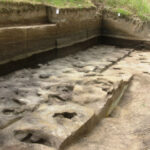Jupiter’s moon Ganymede is the only satellite in the Solar System known to have an intrinsic magnetic field. Interactions between this field and the magnetosphere of Jupiter are expected to funnel most of the associated impinging charged particles, which alter surface chemistry across the Jupiter system, to Ganymede’s polar regions. Using observations obtained with the NASA/ESA/CSA James Webb Space Telescope, astronomers have now detected hydrogen peroxide, a radiolysis product of water ice, specifically constrained to the high latitudes of Ganymede.
A spectroscopic map of Ganymede derived from Webb measurements shows light absorption around the poles characteristic of hydrogen peroxide; the circle outlines the surfaces of the moon. Image credit: Samantha Trumbo, Cornell University.
“This shows that we can do incredible science with Webb e on solar system objects, even if the object is really very bright, like Jupiter, but also when you look at very faint things next to Jupiter,” said University of California, Berkeley’s Professor Imke de Pater.
Using measurements captured by Webb’s Near-Infrared Spectrograph (NIRSpec), Professor de Pater and colleagues detected the absorption of light by hydrogen peroxide around the north and south poles of Ganymede, a result of charged particles around Jupiter and Ganymede impacting the ice that blankets the moon.
“Webb revealing the presence of hydrogen peroxide at Ganymede’s poles shows for the first time that charged particles funneled along Ganymede’s magnetic field are preferentially altering the surface chemistry of its polar caps,” said Dr. Samantha Trumbo, a postdoctoral researcher at Cornell University.
According to the team, hydrogen peroxide is produced by charged particles hitting the frozen water ice around the poles of Ganymede and breaking the water molecules into fragments — a process called radiolysis — which then recombine to form Ganymede.
The authors suspected that radiolysis would occur primarily around the poles on Ganymede because, unlike all other moons in our Solar System, it has a magnetic field that directs charged particles toward the poles.
“Just like how Earth’s magnetic field directs charged particles from the sun to the highest latitudes, causing the aurora, Ganymede’s magnetic field does the same thing to charged particles from Jupiter’s magnetosphere,” Dr. Trumbo said.
“Not only do these particles result in aurorae at Ganymede, as well, but they also impact the icy surface.”

Ganymede, larger than even Mercury and Pluto, has an icy surface speckled with bright young craters overlying a mixture of older, darker, more cratered terrain laced with grooves and ridges; the large circular feature on the upper right, called Galileo Regio, is an ancient region of unknown origin; Ganymede is thought to have an ocean layer that contains more water than Earth and might contain life; like Earth’s Moon, Ganymede keeps the same face towards its central planet, in this case Jupiter; this image was taken about 20 years ago by NASA’s Galileo probe, which ended its mission by diving into Jupiter’s atmosphere in 2003; currently, NASA’s Juno spacecraft orbits Jupiter and is studying the giant planet’s internal structure, among many other attributes. Image credit: NASA / JPL / Galileo probe.
Planetary researchers had earlier studied hydrogen peroxide on Europa, another of Jupiter’s four Galilean satellites.
On Europa, however hydrogen peroxide was detectable over much of the surface, perhaps, in part, because it has no magnetic field to protect the surface from the fast-moving particles zipping around Jupiter.
“This is likely a really important and widespread process,” Dr. Trumbo said.
“These observations of Ganymede provide a key window to understand how such water radiolysis might drive chemistry on icy bodies throughout the outer Solar System, including on neighboring Europa and Callisto.”
“It helps to actually understand how this so-called radiolysis works and that, indeed, it works as people expected, based on lab experiments on Earth,” Professor de Pater said.
The discovery is reported in a paper in the journal Science Advances.
_____
Samantha K. Trumbo et al. 2023. Hydrogen peroxide at the poles of Ganymede. Science Advances 9 (29); doi: 10.1126/sciadv.adg3724




